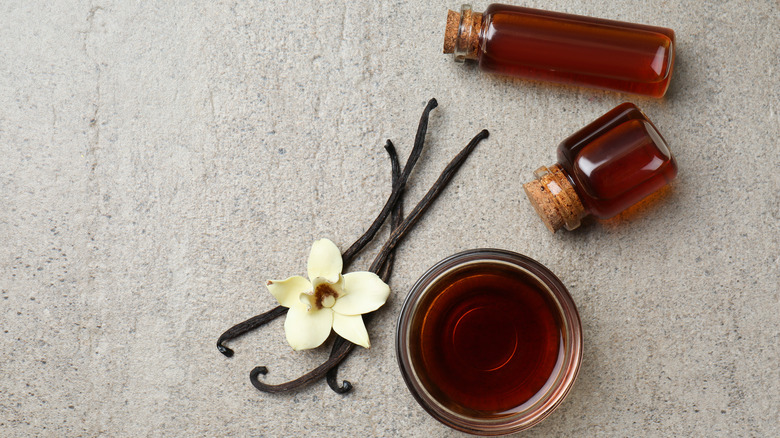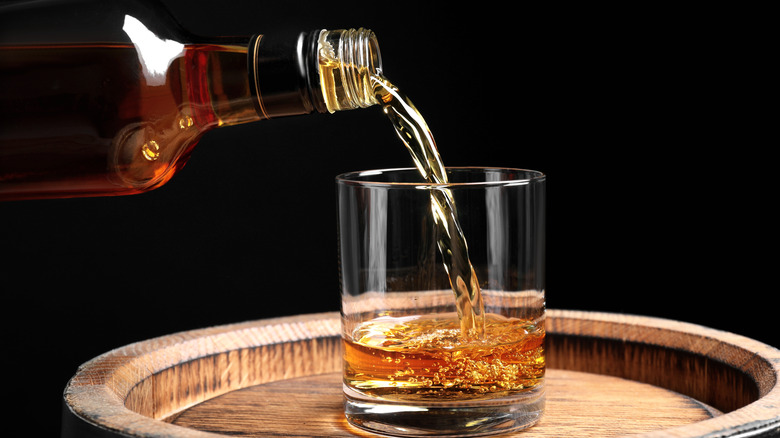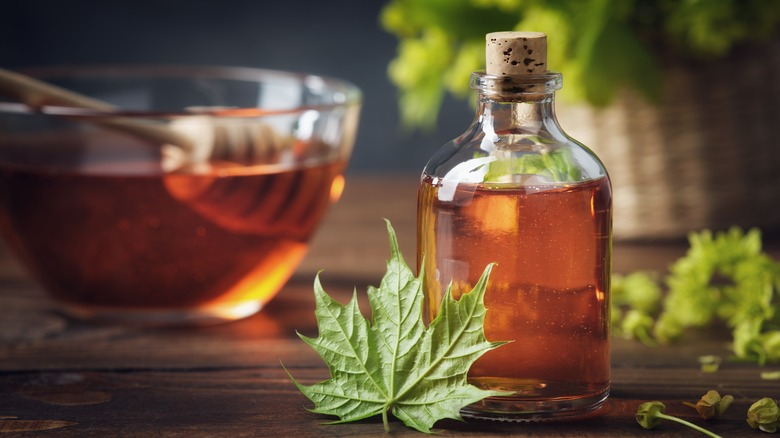The Boozy Vanilla Extract Alternative You Need In Rotation
Every cook knows the feeling of reaching for an ingredient you swore you had, only to find it has pulled a disappearing act. Maybe someone else finished the last drops of vanilla or perhaps you're in the mood to experiment — regardless of why you're passing over the usual rich ingredient, you'll need to figure out a substitute. That's where your liquor cabinet comes in.
Vanilla is unique in its heady aroma, so you won't capture the exact same essence. However, evenly swapping the same amount of the liquid for concentrated bourbon will allow you to replicate some of the nuance it adds to desserts. The drink brings in similar notes of caramel, as well as floral or nuttiness depending on the brand. Like vanilla, it can serve as a bridge to help connect the different ingredients while muting overly eggy flavors too (here's looking at you pudding and crème brûlée).
This tip works best in recipes that aren't centered around the scent of vanilla — think nutty pies and gooey brownies, rather than crème anglaise or shortbread. Although you can top your pastries with vanilla salt to add a balanced savory-sweet seasoning, the finishing salt won't penetrate in quite the same way and too much could throw off the sodium levels. Instead, count on bourbon to boost everything from whipped cream to spiced carrot cake.
Swapping bourbon for vanilla
Though they may share a name, Bourbon vanilla does not contain the drink bourbon. Bourbon vanilla beans, also referred to as Madagascar vanilla, are named for France's Bourbon Island (now Réunion), which is located east of Madagascar. Instead, bourbon is a favorite substitute because it's made in flavorful oak barrels, which impart some of the same scent compound, vanillin, found in the extract. Some Madagascar beans actually mature in oak barrels, too, adding to the similarities with the grain alcohol.
As for the brand of the booze, you probably won't want to use your best stuff. Similar to when it comes to cooking with whiskey, skip the top shelf. This is the time to choose one of the best value bourbons on liquor store shelves to allow tasty aromas to come through even if some of the more subtle qualities fade into the batter.
A teaspoon or two will not add an overwhelming boozy flavor, but it won't add much flavor in general. Instead, you can gently heat the liquid into a concentrate on the stove or in the microwave — allowing some of the alcohol to cook out but also for the flavor to intensify. Technically, about 25% of the alcohol will linger even after an hour of cooking. However, at this low quantity, you're unlikely to notice the added component.
Other substitutes for the sweet extract
Although bourbon offers the closest complexity, there are other ingredients that can hold their own. Other dark liquors, like rum and Cognac, capture a similarly nuanced scent. Plus, you can seek out brands similarly aged in aromatic oak barrels to replicate notes of vanilla and spice.
Maple syrup is another common substitute for the extract. The sweetener may slightly alter the balance of some desserts, but you can use the two liquids interchangeably. Honey can also bring a warm, floral flavor, but it contains additional sugar, so you may want to taste your dessert and adjust as needed.
Alternatively, home cooks can also embrace other flavorings to compensate for the lack of pep vanilla normally brings. Instead of bourbon in brownies, for example, add smoky and rich instant espresso powder or brewed coffee to make the cocoa pop — that's what Ina Garten does in her chocolate cake. In nutty or spiced desserts, about half of the amount of almond extract or a generous teaspoon of orange zest can draw out other complementary notes.



